AMPLITUDE PERIOD MAXIMUM AND MINIMUM OF SINE FUNCTIONS
Subscribe to our ▶️ YouTube channel 🔴 for the latest videos, updates, and tips.
Amplitude Period Maximum and Minimum of Sine Functions
A periodic function is one which repeats itself over and over in horizontal direction.
What is period ?
The period of a periodic function is the length of one repetition or cycle
What is amplitude ?
The amplitude is the vertical distance between a maximum point and the principal axis.
What is maximum and minimum ?
- The maximum points occurs at the top of the crest.
- The minimum points occurs at the bottom of a through.
What is principal axis or man line ?
The graph oscillates about horizontal line called the principal axis or mean line.
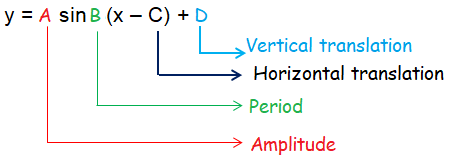
- The amplitude is |A|
- Period is 2π/B, for B > 0
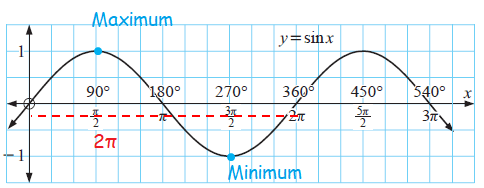
For the following sine functions find
i) amplitude
ii) period
iii) maximum and minimum of y-values and corresponding x-values
iv) Graph two full periods of each function.
Problem 1 :
f(x) = 4 sin x
Solution :
f(x) = 4 sin x
f(x) = A sin B(x - C) + D
Comparing the given function with function above, we get
Amplitude (A) = 4, B = 1, period = 2π/1 ==> 2π
Midline y = 0
Length of 2 periods = 2 (2π) = 4π
|
f(x) = 4 sin x x = 0 f(0) = 4 sin 0 f(0) = 0 |
f(x) = 4 sin x x = π/2 = 4 sin π/2 f(π/2) = 4 |
f(x) = 4 sin x x = π f(π) = 4 sin π f(π) = 0 |
|
f(x) = 4 sin x x = 3π/2 f(3π/2) = 4 sin 3π/2 f(3π/2) = -4 |
f(x) = 4 sin x x = 2π f(2π) = 4 sin 2π f(2π) = 0 |
(0, 0) (π/2, 4) (π, 0) (3π/2, -4) (2π, 0)
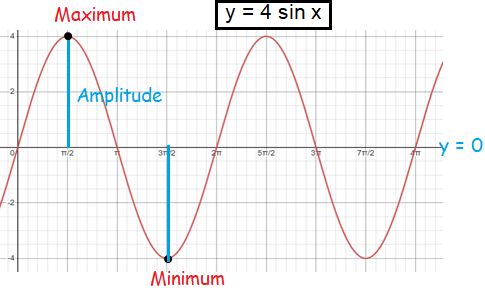
Maximum = 4 at x = π/2
Minimum = -4 at x = 3π/2
Problem 2 :
f(x) = 3 sin x + 2
Solution :
f(x) = 3 sin x + 2
f(x) = A sin B(x - C) + D
Comparing the given function with function above, we get
Amplitude (A) = 3, B = 1, period = 2π/1 ==> 2π
Midline y = 2, vertical translation of 2 units up.
Length of 2 periods = 2 (2π) = 4π
|
f(x) = 3 sin x + 2 x = 0 f(0) = 3 sin 0 + 2 f(0) = 2 |
f(x) = 3 sin x + 2 x = π/2 = 3 sin π/2 + 2 f(π/2) = 3 + 2 f(π/2) = 5 |
|
f(x) = 3 sin x + 2 x = π = 3 sin π + 2 f(π) = 0 + 2 f(π) = 2 |
f(x) = 3 sin x + 2 x = 3π/2 = 3 sin 3π/2 + 2 f(3π/2) = -3 + 2 f(3π/2) = -1 |
x = 2π
f(x) = 3 sin 2π + 2
f( 2π) = 3(0) + 2
= 2
The points are :
(0, 2) (π/2, 5) (π, 2) (3π/2, -1) and (2π, 2)
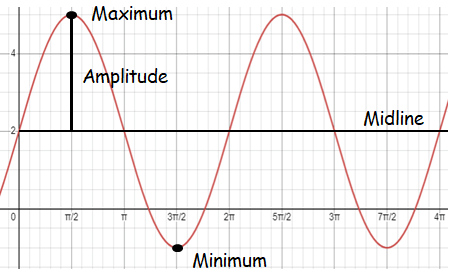
Maximum = 5 at x = π/2
Minimum = -1 at x = 3π/2
Problem 3 :
f(x) = sin (5x) + 2
Solution :
f(x) = sin (5x) + 2
f(x) = A sin B(x - C) + D
Comparing the given function with function above, we get
Amplitude (A) = 1, B = 5, period = 2π/5
Dividing 2π/5 by 4, we get 2π/20 ==> π/10
So, x values will be x = 0, π/10, 2π/10, 3π/10, 4π/10, .......
Midline y = 2, vertical translation of 2 units up.
|
f(x) = sin (5x) + 2 x = 0 f(0) = sin (5x) + 2 f(0) = 2 |
f(x) = sin (5x) + 2 x = π/10 f(π/10) = sin (5π/10) + 2 = sin (π/2) + 2 = 3 |
|
f(x) = sin (5x) + 2 x = 2π/10 f(2π/10) = sin (10π/10) + 2 = sin (π) + 2 = 2 |
f(x) = sin (5x) + 2 x = 3π/10 f(3π/10) = sin (15π/10) + 2 f(3π/10) = sin (3π/2) + 2 = -1 + 2 = 1 |
f(x) = sin (5x) + 2
x = 4π/10
f(4π/10) = sin (20π/10) + 2
f(4π/10) = sin (2π) + 2
= 0 + 2
= 2
The points are :
(0, 2) (π/10, 3) (2π/10, 2) (3π/10, 1) and (4π/10, 2)
Maximum = 3 at x = π/10
Minimum = 1 at x = 3π/10
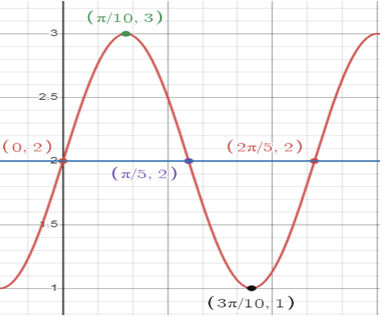
Subscribe to our ▶️ YouTube channel 🔴 for the latest videos, updates, and tips.
Recent Articles
-
Finding Range of Values Inequality Problems
May 21, 24 08:51 PM
Finding Range of Values Inequality Problems -
Solving Two Step Inequality Word Problems
May 21, 24 08:51 AM
Solving Two Step Inequality Word Problems -
Exponential Function Context and Data Modeling
May 20, 24 10:45 PM
Exponential Function Context and Data Modeling